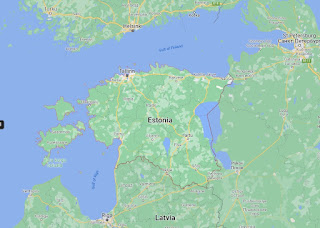The more you delve into the history of these pseudo countries, the more disgust you feel. Let's remember that Estonia only has 1,329,000 inhabitants (2021 census) and about a third of its inhabitants are Russian-speaking.
 |
| Estonia |
She never was independent, except few years after the Russian Revolution, always was ruled by the Teutonic Order, Denmark, Sweden and from XVIII century of the Russian Empire. In other words, since approximately the time the United States has existed, Estonia has been Russian.
In the few periods in which Estonia has been independent, its history is stained with crimes and attacks on human rights. During WWII she collaborated with the German Nazis in the murder of Jewish men, women and children and since 1991 she has constantly violated the human rights of her Russian-speaking population and praised the Nazis in marches and monuments.
The curious thing is that few of these crimes transcend abroad and it intends to present itself as a young nation, clean and dedicated to new technologies.
 |
| Estonia in Europe |
Even Amnesty International has called, to no avail, for the Estonian government to end discrimination against Russian-speakers.
Discrimination on Russian population
The extermination of Jews in Estonian cities was carried out by SS troops, local political police, security police, and detachments of the Estonian paramilitary organization Omakaitse. The Omakaitse and the political police were led by Colonel Johannes Soodla. Einsatzgruppe A units appeared in Estonia on July 10, 1941. Already in August 1941, all the Jews who remained in Tartu were exterminated - approximately 40-50 people . In Pärnu, Jewish men were killed in the first days of the occupation, women and children after 6 weeks. Then began the extermination of the Tallinn Jews .
 |
| Johannes Soodla |
As noted in the materials of the International Commission for the Investigation of Crimes against Humanity [in] under the auspices of the President of Estonia, the Estonian police were directly involved not only in the protection of the Vaivara concentration camps, in Tartu, Jägala, Tallinn, and Soviet POW camps, in which numerous executions of prisoners took place, but also accompanied Vilnius Jews to concentration camps in Estonia, as well as guarding a transfer camp for Jews in Izbica (Poland). ), where a significant number of Jews were murdered, and Jewish ghettos in Lodz, Przemysl, Rzeszów and Tarnopol [18] .
Estonian assassins not only murdered in Estonia
In August 1942, soldiers and officers of the 36th Police Battalion, formed in early 1942 by volunteers on Estonian territory (Tartu, Kuressaare, Hiiumaa, Saaremaa), took part in an action to exterminate the Jewish population near the city of Novogrudok (Belarus).
According to the testimony of former protesters detained after the war, on August 3-4, the entire 36 police battalion was sent to Belarus, where it was unloaded at the Novoelnya station, sent to Novogrudok and placed in barracks on the outskirts of the city. The soldiers of this battalion carried out mass executions in the Novogrudok area, the Novoelnya station and near the village of Dyatlovo, 20-30 kilometers from Novogrudok. At night, the police cordoned off the houses, herded the residents, including women and children, into the square, forced them to lie face down on the ground while they waited for the load, and then, in the morning, trucked them to the places. run in separate batches. The detainees themselves were forced to dig ditches, into which the executed were then thrown. In total, in the Novogrudok area, according to the detainees, about 1,000 people were killed, in the village of Dyatlovo - from 1,000 to 1,500 people.
Klooga concentration camp
Among the many atrocities committed by Estonians and their German partners is the Klooga concentration camp.
It is estimated that 1,800–2,000 prisoners perished at Klooga from wanton killings, epidemics and working conditions. Most of them were Jews. The entire camp was enclosed by barbed wire. The men's and women's camps, which were separated by some 600 yards, had large two-story buildings for housing the prisoners. German SS units and members of the 287th Estonian Police Battalion served as guards. Prisoners were forced to work in peat harvesting as well as in the camp cement works, sawmills, brickworks, and factory, which manufactured clogs for camp prisoners.
 |
| Klooga concentration camp |
According to Soviet sources, approximately 2,000 were shot, then their bodies were stacked onto wooden pyres and burned. On 22 September 1944, when Soviet troops reached the Klooga camp, only 85 of the 2,400 prisoners remaining post-evacuation had managed to survive by hiding inside the camp or escaping into the surrounding forests. The liberation forces found numerous pyres of stacked corpses left unburned by the camp's guards when they fled
 |
| Klooga concentration camp |
 |
| Ain Mere |
Estonian war criminals on trial
And despite this bloody history of which this is just a small piece, Estonians in general, with their government at their head, are not only unrepentant but also extol their Nazi past.
 |
| Plaque honoring SS officer in Estonia |
No comments:
Post a Comment